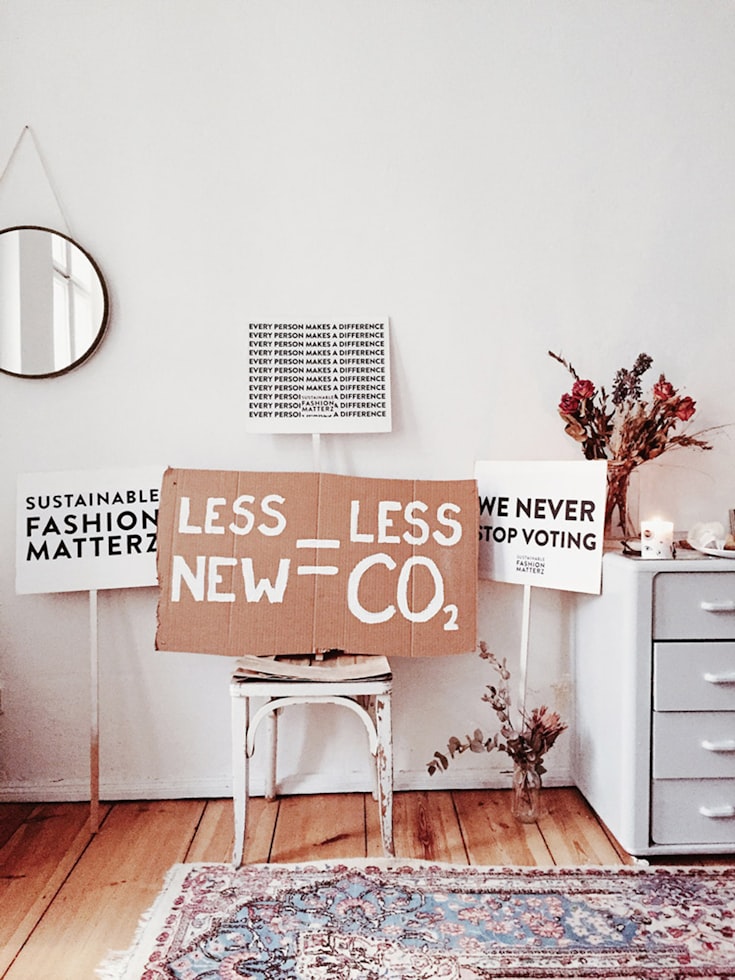Contemporary fashion industry is one of the most influential and notorious industries that exist today. Known for its never-ending change and innovation, fashion always strives to bring something new, never seen before or thought of until now. Unfortunately, this constant evolution comes with a significantly impactful carbon footprint on the planet, which begs the question: is it worth it?
Luckily, the rise of new sustainable solutions, such as recycling fabrics and ethical production methods, is ensuring that fashion is working towards environmental preservation while still creating unique styles. This has brought forth a change in sustainable fashion trends that classify themselves as ecological, ethical, and fair trade. It signals an entirely new era in fashion, with a shift in focus to maximize the mutual benefits for both planet and people.
The fashion industry is becoming increasingly aware of its responsibilities towards the environment and is taking active steps to adopt eco-friendly practices. Companies are now incorporating sustainable alternatives that reduce the amount of chemicals used in production, source fabrics from organic and recycled materials, and prioritize ethical and fair production standards. These changes are crucial, as they reduce the impact of wastage and pollution, which the industry significantly contributes to, and increase overall sustainability levels.
Consumers are also becoming increasingly conscious of the environmental impact their purchases have on the planet. They show a growing preference for sustainable and eco-friendly fashion, with many choosing to change their shopping habits accordingly. People no longer buy excessively, and there is increasing awareness of the importance of choosing sustainable options wherever possible. This has led to improved transparency from companies regarding their production methods, prices, material origins, and waste management systems.
There is also ongoing research and development in eco-friendly alternatives for textiles and packaging materials that offer the potential for sustainable and cost-effective production. The focus is on sourcing materials from renewable resources and reducing waste in production. This allows designers and manufacturers to meet customer expectations while still implementing a more sustainable approach to production. It increases the likelihood of reducing the carbon footprint of the fashion industry in the long term.
The future of fashion is sustainable, with eco-innovation becoming an essential part of the industry. By adopting sustainable practices and embracing eco-friendly alternatives and creating pricing policies that account for social and environmental costs, the fashion industry will be able to address concerns related to climate change, pollution, waste, and global inequality. It will create a future where fashion is seen as a positive force for the planet rather than a threat.
To conclude, fashion is an industry that has one of the largest impacts on our planet. But with the recent shifts towards eco-friendliness, sustainable practices, and ethical production standards, there is now an opportunity to create a more sustainable future for fashion. It is time for consumers, designers, and companies to work together to reduce the industry’s carbon footprint in favor of a more sustainable and equitable future.
The fashion industry is one of the largest contributors to global pollution, with its traditional methods producing massive amounts of waste and greenhouse gas emissions. However, the tide is turning as more and more fashion brands are recognizing the importance of sustainable practices. From eco-friendly materials to ethical manufacturing processes, sustainable fashion is becoming the new normal. This article will explore the ways in which sustainable practices are changing the fashion industry and what we can expect for the future of fashion.
1. The rise of eco-friendly materials
One of the most significant changes in the fashion industry is the increased use of eco-friendly materials. The traditional methods of using harsh chemicals and non-renewable resources to create fabrics are being replaced with sustainable options like organic cotton, bamboo, and hemp. These materials are not only better for the environment, but they also offer consumers a higher level of comfort and quality. As technology advances, we can expect to see even more innovative and eco-friendly materials being developed to replace traditional fabrics.
2. Ethical manufacturing processes
Sustainable fashion also means ethical manufacturing processes, which includes fair labor practices and reducing waste in production. Brands are investing in transparency and ensuring that every stage of their supply chain, from sourcing materials to final production, is ethical and sustainable. Many brands are also implementing circular business models, in which materials are recycled and repurposed instead of being discarded. This reduces waste and creates a more efficient and sustainable manufacturing process.
3. The impact of fast fashion
Fast fashion has long been a major contributor to the fashion industry’s negative impact on the planet. The trend of cheap and disposable clothing has resulted in a culture of overconsumption, where consumers buy clothes frequently and discard them just as quickly. However, sustainable fashion is changing this model by promoting slower, more intentional consumption. Brands are designing clothes that are made to last and encouraging consumers to invest in pieces that will stand the test of time, rather than constantly buying and discarding fast fashion items.
4. The role of technology in sustainable fashion
Technology is playing a major role in the future of sustainable fashion. From new materials to innovative manufacturing processes, technology is enabling brands to create sustainable products in new and exciting ways. For example, 3D printing technology can be used to create clothing without any waste, and upcycling technology can turn old clothing into new items, reducing the need for new materials.
5. The growth of conscious consumerism
As consumers become more aware of the impact that their purchases have on the environment and society, the demand for sustainable fashion is growing. Conscious consumerism means choosing brands that prioritize sustainability, supporting ethical and transparent supply chains, and demanding that the fashion industry becomes more accountable for its environmental impact. As the demand for sustainable fashion grows, we can expect to see more and more brands adopting sustainable practices and offering consumers eco-friendly fashion choices.
6. The importance of education and awareness
Education and awareness are key to the future of sustainable fashion. Consumers can play a vital role in driving the industry towards sustainability by educating themselves on the impact of their purchases and demanding more sustainable options. Brands and retailers can also have a significant impact by educating their customers about sustainable practices and making eco-friendly products more accessible and affordable.
7. The challenges ahead
Despite the progress being made in the fashion industry towards sustainability, there are still many challenges ahead. The cost of sustainable materials and ethical manufacturing processes can be higher, which can make it difficult for some brands to incorporate them into their business models. Additionally, the fast pace of the industry and the pressure to constantly produce new and trendy clothing can make it challenging to maintain sustainable practices. However, with continued education, awareness, and innovation, the future of fashion looks bright.
Summary
The fashion industry is making a shift towards eco-friendliness and sustainability, driven by the growing awareness of its environmental impact and the rising demand for sustainable and ethical fashion among consumers. Companies are adopting sustainable practices such as using organic and recycled fabrics, reducing chemicals in production, and prioritizing ethical and fair trade standards. There is also ongoing research in eco-friendly alternatives for textiles and packaging materials that offer cost-effective production. By working together, the fashion industry can create a more sustainable and equitable future, where fashion is seen as a positive force for the planet.

FAQ
What does sustainable fashion mean?
Sustainable fashion is a concept that refers to the production of clothes and accessories that have minimal negative environmental impact. This means that sustainable fashion involves the use of eco-friendly materials, reducing waste, supporting ethical labor practices, and ensuring the longevity of the products.
Sustainable fashion brands focus on reducing the harmful effects of the industry on the environment by using materials that are organic or recycled, reducing waste through creative design and manufacturing techniques, and ensuring that workers in the supply chain are ethically treated. Sustainable fashion is a move towards a circular economy, where materials are reused and recycled, and the industry has a decreasing ecological footprint.
How can consumers be a part of the sustainable fashion movement?
Consumers can participate in sustainable fashion by being more intentional in their clothing choices. They can start by reducing their consumption of fast fashion, which is a significant contributor to environmental harm. Instead, they can look to buy clothes from sustainable fashion brands that use eco-friendly materials and support ethical labor practices.
Consumers can also take care of their clothes by washing them less frequently, repairing any damages, and donating old clothes instead of throwing them away. By shopping less but better, consumers can contribute to the sustainable fashion movement and create a more conscious and positive impact.
How do sustainable practices impact the fashion industry’s bottom line?
Sustainable practices can provide significant economic benefits to the fashion industry. Firstly, by designing more durable, quality products, sustainable fashion brands can create long-lasting value for the consumer, resulting in repeat purchases and higher customer loyalty. Additionally, innovative sustainable practices like reducing waste, using eco-friendly materials, and supporting ethical labor practices can ultimately reduce production costs.
Consumers are also becoming more conscious of the impact of their purchase decisions on the environment, meaning that brands that prioritize sustainability can attract more customers and increase their brand value. Therefore, sustainable practices are not only ethically responsible but also financially prudent, helping businesses to increase their profits and build a positive brand reputation.
What is the future of sustainable fashion?
The future of sustainable fashion looks promising, with more consumers becoming conscious of their environmental impact and the fashion industry’s responsibility towards sustainability. Brands are adopting sustainable practices across their supply chains, rethinking their entire business models to minimize waste and improve their environmental impact.
Technological innovations are also revolutionizing the industry, with advancements in materials and manufacturing techniques that are more environmentally friendly. These innovations are enabling brands to produce clothes with more innovative, sustainable materials like biodegradable fabrics or fabrics made from plastics. The future of sustainable fashion, therefore, looks positive, with innovative sustainable practices shaping the industry towards an environmentally conscious future.




